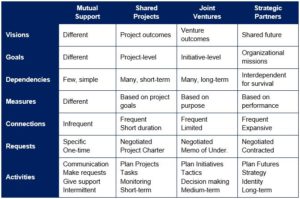Summary
Whether just getting started or looking to work together more closely, networks and partnerships will find they have a lot of questions. These questions usually relate to WHO is influential, interested and involved in this space, WHAT do we want to work on together, and HOW can we organize ourselves to achieve our mutual goals.
- In the EXPLORATION STAGE, there is a heavy emphasis on understanding context and WHO to invite to the conversation.
- The FORMATION STAGE often explores questions of “WHAT”. What do we want to do together? What is the problem that brings us together and what is our vision, priorities and goals for responding to it?
- The OPERATION STAGE is where questions around “HOW” are addressed. These are questions related to how we want to work together, our mutual expectations for each other and the network, and how do we want to organize to achieve these goals?
This article pre-supposes that the WHO and WHAT conversations have largely already taken place. To answer the “HOW” questions, the author suggests that networks and partnerships first explore a more fundamental question” What kind of collaborative pattern (structure) will best move you and your partners toward your shared goals?
Glenda Oeyang explains that, “As long as both partners agree to the purpose and pattern of their collaboration, then the other questions are much easier to ask—and answer in context.”
In this article, Glenda Eoyang discusses Four levels of collaborative engagement and shows how the expectations associated with each level change as organizations and networks begin to work more closely together.
While the context of this article is focused more on “organizational collaborations” the principles and patterns apply just as easily to networks. visionSynergy often talks about this collaboration continuum using the terms “Communication, Cooperation, Coordination, and Collaboration“
For Reflection
- Which pattern best fits your ministry collaboration or network?
- Are your desired outcomes and expectations aligned with this pattern and purpose?
- What pattern would best fit your desired purpose?
Citation
- Glenda Oeyang. Patterns of Collaboration. Article. Human Systems Design. September 2018.


